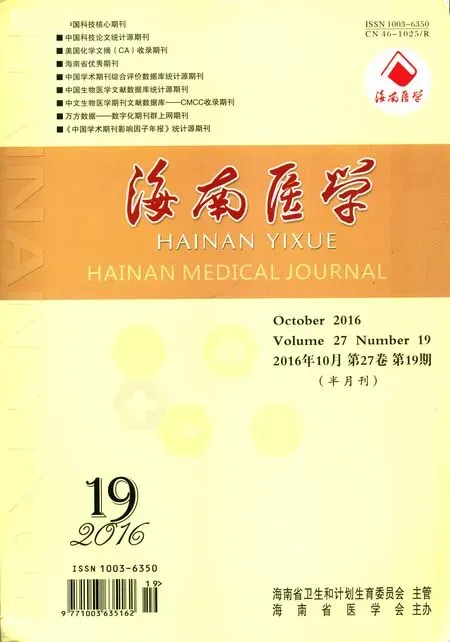骨鈣素在糖代謝中的研究進展
楊焱平,封啟明
(上海交通大學附屬第六人民醫院急診醫學科,上海 200233)
骨鈣素在糖代謝中的研究進展
楊焱平,封啟明
(上海交通大學附屬第六人民醫院急診醫學科,上海 200233)
骨鈣素(Osteocalcin,OC)是成骨細胞分泌并沉積在骨基質中的非膠原蛋白,參與骨的礦化。糖代謝可以影響成骨細胞活性,最近研究發現羧化不全骨鈣素(uncarboxylatedostecalcin,ucOC)可以促進小鼠胰島β細胞增殖,胰島素分泌,增強胰島素敏感性,進而調控血糖。在糖尿病人群中也發現骨鈣素含量與血糖、胰島素抵抗等存在相關性,這將有助于在控制血糖領域的研究。
骨鈣素;血糖;胰島素;胰島素受體
一直以來,骨骼僅僅被認為是構成機體的結構器官,但近年來人們發現骨骼也是一種內分泌器官。通過對小鼠的研究顯示小鼠體內成骨細胞分泌的骨鈣素增加可以調節脂肪含量、促進胰島β細胞增殖、增加胰島素的表達及分泌,降低血糖和改善糖耐量,進而調控機體能量代謝[1]。骨鈣素作為一種由內分泌激素影響糖代謝越來越受到關注,本文主要闡述關于骨鈣素對糖代謝影響的研究進展。
1 OC的基本情況
OC是一種沉積于骨基質中的非膠原蛋白,由成骨細胞、成牙質細胞、軟骨細胞分泌,最近研究發現循環內皮祖細胞(circulating endothelial progenitor cells,EPCs)中亦可檢測到骨鈣素的存在[2]。骨鈣素基因包含4個外顯子和3個內含子,轉錄和翻譯過程受維生素D3和維生素K2的影響[3],翻譯形成的前體骨鈣素含98個氨基酸,該肽鏈在內質網轉移的過程中經過兩次裂解,形成含49個氨基酸,分子量約為5 800。絕大多數骨鈣素[4]在受體樣跨膜蛋白酪氨酸磷酸酶(osteoblast protein tyrosine phosphatase,OST-PTP)和維生素K依賴的γ-谷氨酸羧化酶(γ-glutamylcarboxylase,GGCX)的作用下形成肽鏈中17、21和24號位含γ-羧基谷氨酸殘基的羧化骨鈣素(carboxylated ostecalcin,cOC)[5]。cOC與鈣離子親和力高,有利于結合羥磷灰石沉積于骨基質中[6],小部分骨鈣素以羧化不全骨鈣素(uncarboxylatedostecalcin,ucOC)的形式釋放入血[3]。血漿中總OC含量依賴于成骨細胞功能,而ucOC含量依賴維生素K活性[7]。目前已經證實ucOC為骨鈣素的活性形式參與能量的調節[1]。
2 OC在糖代謝中的研究進展
2.1 胰島素-骨鈣素信號前饋調節的形成 胰島素可以通過成骨細胞膜上的胰島素受體(insulin receptor,Insr)促進成骨細胞增殖和分化,增加骨鈣素mRNA的表達和OC的分泌[8],而血清ucOC通過作用于胰島β細胞膜上的G蛋白耦聯受體C家族6組(G-protein-coupled receptor 6a,Gprc6a)使小鼠胰島β細胞增殖、胰島素表達及分泌增加[1],該過程為胰島素-骨鈣素信號前饋調節[3]。
2.1.1 增強胰島素-骨鈣素信號前饋調節的途徑胰島素不僅有促進成骨細胞分化的作用[8-9],也可通過成骨細胞膜Insr減弱TWIST2對RUNX2的抑制作用,使鏈接到骨鈣素啟動子的RUNX2比例增加,增強骨鈣素啟動子的表達[8-10];同時能使骨保護素(osteoprotegerin,OPG)的減少表達[8],減弱OPG對核因子κB受體活化因子配體(receptor activator for nuclear factor-κB ligand,RANKL)的抑制,進而增加破骨細胞的活性,促使骨基質形成pH 4.5的微環境,該酸性環境中骨基質cOC第C17脫羧,形成ucOC進入血液[11]。以上多種途徑共同使血清ucOC濃度增加,增加的ucOC不僅可以直接作用于胰島細胞膜表面的Gprc6a,也可通過刺激腸細胞的Gprc6a使腸細胞分泌人胰高血糖素樣肽1 (glucagon-like peptide-1,GLP-1)增加[12-13],間接促進胰島素分泌增多;另外,血清ucOC不僅可以保護高血糖環境下小鼠胰島細胞的功能[14],也可以刺激脂肪細胞分泌脂聯素進而增強胰島素的敏感性[1]。
2.1.2 減弱胰島素-骨鈣素信號前饋調節的途徑 研究發現Esp基因敲除的小鼠血清ucOC水平升高,表明Esp基因介導OC的生成[1]。Esp基因在小鼠成骨細胞中特異性表達生成OST-PTP,在GGCX的協同作用下可以使ucOC羧化成cOC;ESP的活性受轉錄激活因子-4(activating transcription factor 4,ATF4)和FoxO1的調節,ATF4或FOXO1可與ESP啟動子相連,促進下游ESP表達OST-PTP[15-17],同時OST-PTP可以抑制Insr的活性[11],阻礙ucOC的生成。除此之外,持續高血糖不僅可降低成骨細胞Insr對胰島素的敏感性,產生胰島素抵抗,也可直接抑制成骨細胞生長和骨鈣素表達的作用[18],Hamada等[19]還發現高血糖對成骨細胞有直接的毒害作用,這可能與高血糖刺激活性氧簇(reactive oxygen species,ROS)增多、削弱成骨細胞功能有關[20]。
2.2 OC與糖代謝的關系 Lee等[1]發現OC缺失小鼠表現出胰島體積和胰島β細胞數目下降,血漿中胰島素濃度及胰島素敏感性降低,而血糖濃度升高,出現胰島素抵抗,而外源性OC能改善該現象,這暗示OC與糖代謝可能呈負相關關系。臨床研究發現糖尿病患者血清OC呈低水平,同時大部分橫斷面研究均顯示血清骨鈣素與糖代謝指標存在負相關關系,即血清骨鈣素水平越低,血糖越高,這種負相關關系同樣存在于血清骨鈣素水平與糖化血紅蛋白及胰島素抵抗指數之間[21-25]。血清骨鈣素水平越高,穩態模型評估的胰島β細胞功能越好,這種相關關系同樣存在于不同糖耐量狀態及不同性別的人群中[26-28]。骨鈣素與上述指標的負相關關系在糖耐量正常人群、Ⅰ型糖尿病及Ⅱ型糖尿病患者中均存在[29-31]。而且在不同性別、年齡、體重指數、種族以及是否絕經等狀態下,骨鈣素與糖代謝指標之間的變化趨勢似乎都不受影響[32]。
3 展望
動物實驗表明不同濃度的外源性ucOC能調節血糖代謝[1],口服骨鈣素能通過GLP-1途徑促進胰島素分泌,胰島細胞增殖,降低血糖等[13]。骨鈣素對機體能量代謝平衡起著重要的調控作用。在人群中對包括骨鈣素在內的骨轉換血清指標及其功能的進一步研究,有可能為糖尿病的發生發展及治療提供新的理論依據和思路。近些年的研究多集中于骨鈣素與胰島β細胞的信號交流,ucOC的受體Gprc6a在胰島素靶組織如骨骼肌、肝臟、脂肪組織內都有分布,關于其作用機制的研究目前很少,而且人的內分泌系統錯綜復雜,骨、胰島、胰島素靶器官等之間的各種信號通路、各種因素互相影響,難以確定骨鈣素在機體中調節糖代謝和能量代謝中的獨立性作用,因此,也應結合大量臨床、流行病學證據進行綜合評價。同時,骨鈣素能否開辟為降血糖藥物也需要得到進一步研究證實。可見,隨著骨鈣素對糖代謝的影響及其機制進一步闡明,將開辟糖尿病預防和治療全新的領域。
[1]Lee NK,Sowa H,Hinoi E,et al.Endocrine regulation of energy metabolism by the skeleton[J].Cell,2007,130(3):456-469.
[2]Mario G,Ulrike IM,Elizabeth JA,et al.Osteocalcin expression by circulating endothelial progenitor cells in patients with coronary atherosclerosis[J].Journal of the American College of Cardiology, 2008,52(16):1314-1325.
[3]Shao J,Wang Z,Tieyi Y,et al.Bone regulates glucose metabolism as an endocrine organ through osteocalcin[J].Int J Endocrinol,2015, 2015:967673.
[4]Berkner KL.Vitamin K-dependent carboxylation[J].Vitamins and Hormones,2008,78:131-156.
[5]Lee NK,Karsenty C.Reciprocal regulation of bone and energy metabolism[J].Trends Endocrinol Metab,2008,19(5):161-166.
[6]Collins NC,Thordal-Christensen H,Lipka V,et al.SNARE-protein-mediated disease resistance at the plant cell wall[J].Nature, 2003,425(6961):973-977.
[7]Booth SL,Amanda C,Smith SR,et al.The role of osteocalcin in human glucose metabolism:marker or mediator?[J].Nat Rev Endocrinol,2013,9(1):43-55.
[8]Fulzele K,Riddle RC,Di Girolamo DJ,et al.Insulin receptorsignaling in osteoblasts regulates postnatal bone acquisition and body composition[J].Cell,2010,142(2):309-319.
[9]Fulzele K,DiGirolamo DJ,Liu Z,et al.Disruption of the insulin-like growth factor type 1 receptor in osteoblasts enhances insulin signaling and action[J].J Biol Chem,2007,282(35):25649-25658.
[10]Bialek P,Kern B,Yang X,et al.Atwist code determines the onset of osteoblast differentiation[J].Dev Cell,2004,6(3):423-435.
[11]Mathieu F,Jianwen W,Tatsuya Y,et al.Insulin signaling in osteoblasts integrates bone remodeling and energy metabolism[J].Cell, 2010,142(2):296-308.
[12]Mizokami A,Yasutake Y,Gao J,et al.Osteocalcin induces release of glucagon-like peptide-1 and thereby stimulates insulin secretion in mice[J].PLoS One,2013,8(2):e57375.
[13]Mizokami A,Yasutake Y,Higashiet S,et al.Oral administration of osteocalcin improves glucose utilization by stimulating glucagon-like peptide-1 secretion[J].Bone,2014,69:68-79.
[14]Kover K,Yun Y,Pei YT,et al.Osteocalcin protects pancreatic beta cell function and survival under high glucose conditions[J].Biochem Biophys Res Commun,2015,462(1):21-26.
[15]Wang WG,Lian N,Li LZ,et al.Atf4 regulates chondrocyte proliferation and differentiation during endochondral ossification by activating Ihh transcription[J].Development,2009,136(24):4143-4153.
[16]Yoshizawa T,Hinoi E,Jung DY,et al.The transcription factor ATF4 regulates glucose metabolism in mice through its expression in osteoblasts[J].J Clin Invest,2009,119(9):2807-2817.
[17]Rached MT,Kode A,Silva BC,et al.FoxO1 expression in osteoblasts regulates glucose homeostasis through regulation of ostecalcin in mice[J].Journal of Clinical Investigation,2010,120(1):357-368.
[18]Wang WW,Zhang XL,Zheng JQ,et al.High glucose stimulates adipogenic and inhibits osteogenic differentiation in MG-63 cells through cAMP/protein kinase A/extracellular signal-regulated kinase pathway[J].Mol Cell Biochem,2010,338(1-2):115-122.
[19]Hamada Y,Fujii H,Fukagawa M.Role of oxidative stress in diabetic bone disorder.Bone[J].2009,45 Suppl 1:35-38.
[20]Mc Cabe LR.Understanding the pathology and mechanisms of type I diabetic bone loss[J].J Cell Biochem,2007,102(6):1343-1357.
[21]Ding HF,Rong HX,Ji H,et al.Change of serum osteocalcin level in type 2 diabetes mellitus patients and its influencing factors[J].Chinese Journal of Osteoporosis,2008,14(7):471-473.
[22]Kindblom JM,Ohlsson C,Ljunggren O,et al.Plasma osteocalcin is inversely related to fat mass and plasma glu-cose in elderly Swedish men[J].J Bone Miner Res,2009,24(5):785-791.
[23]Kanazawa I,Yamaguchi T,Yamauchi M,et al.Serum undercarboxylated osteocalcin was inversely associated with plasma glucose level and fat mass in type 2 diabetes mellitus[J].Osteoporos Int,2011,22 (1):187-194.
[24]Iki M,Tamaki J,Fujita Y,et al.Serum undercarboxylated osteocalcin levels are inversely associated with glycemicstatus and insulin resistance in an elderly Japanese malepopulation:Fujiwara-kyo Osteoporosis Risk in Men(FORMEN)Study[J].Osteoporos Int,2012,23 (2):761-770.
[25]Im JA,Yu BP,Jeon JY,et al.Relationship between osteocalcin and glucose metabolism in postmenopausal women[J].Clin Chim Acta, 2008,396(1-2):66-69.
[26]Zhou M,Ma X,Li H,et al.Serum osteocalcin concentrations in relation to glucose and lipid metabolism in Chinese individuals[J].Eur J Endocrinol,2009,161(5):723-729.
[27]Bao YQ,Zhou M,Zhou J,et al.Relationship between serum osteocalcin and glycaemic variability in type 2 diabetes[J].Clin Exp Pharmacol Physiol,2011,38(1):50-54.
[28]Bao Y,Zhou M,Lu Z,et al.Serum levels of osteocalcin are inversely associated with the metabolic syndrome and the severity of coronary artery disease in Chinese men[J].Clin Endocrinol(Oxf),2011,75 (2):196-201.
[29]Weiler HA,Lowe J,Krahn J,et al.Osteocalcin and vitamin D status are inversely associated with homeostatic model assessment of insulin resistance in Canadian Aboriginal and white women:the First Nations Bone HealthStudy[J].J Nutr Biochem,2013,24(2):412-418.
[30]Choudhury AB,Sarkar PD,Sakalley DK,et al.Role of adiponectin in mediating the association of osteocalcin with insulin resistance and type 2 diabetes:a cross sectionalstudy in pre-and post-menopausal women[J].Archives of Physiology And Biochemistry,2014,120 (2):73-79.
[31]Maddaloni E,D'Onofrio L,Lauria A,et al.Osteocalcinlevels are inversely associated with Hba1c and BMI in adult subjects with long-standing type 1 diabetes[J].J Endocrinol Invest,2014,37(7): 661-666.
[32]Kim SH,Lee JW,Im JA,et al.Serum osteocalcin is related to abdominal obesity in Korean obese and overweight men[J].Clin Chim Acta,2010,411(23-24):2054-2057.
Research progress of osteocalcin in glucose metabolism.
YANG Yan-ping,FENG Qi-ming.Department of Emergency Medicine,Shanghai Jiao Tong University Affiliated Sixth People's Hospital,Shanghai 200233,CHINA
Osteocalcin(OC),secreted by osteoblasts,is a non-collagen protein and deposits in bone matrix,affecting bone mineralization.Glucose metabolism can affect osteoblast function.Recent studies have shown that uncarboxylatedostecalcin(ucOC)can promote mouse islet beta cells proliferation and insulin secretion,increase insulin sensitivity and control blood glucose.The findings of the correlations between osteocalcin content and glucose,insulin resistance in patients with type 2 diabetes mellitus(T2DM)would contribute to the control of blood glucose.
Osteocalcin;Blood glucose;Insulin;Insulin receptor
R589.1
A
1003—6350(2016)19—3204—03
10.3969/j.issn.1003-6350.2016.19.036
2015-11-13)
封啟明。E-mail:fengqiming04@126.com

